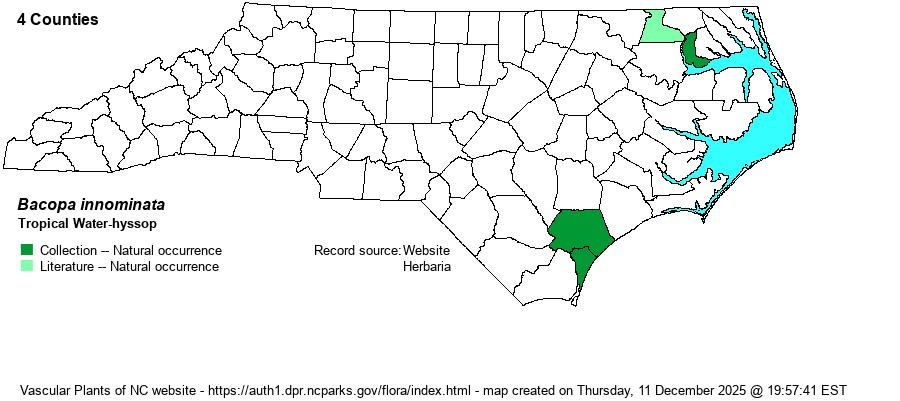| Author | (Gomez Maza) A.H. Liogier | |
| Distribution | Recorded historically from the southeastern corner of the state (Pender and New Hanover counties -- reputedly) and from the northern Coastal Plain (Chowan County). The Chowan record is from 1956, whereas the others are reported in RAB (1968), but there seems to be no record of a specimen for either of these two counties, and thus they might have been misidentified. Note that SERNEC now (2025) has two specimens of B. caroliniana from Chowan County but none from this county for B. innominata! Specimens from Carteret County (Bostick 267-7, several herbaria) were originally determined as B. rotundifolia, but are B. monnieri. It is currently found in a handful (five) of tidewater counties in east-central VA, though these represent what is often considered as B. stragula, but has recently been declared an "intertidal form" of B. innominata (in Weakley 2018). Thankfully, in September 2025, Larry Chen and Sarah Toner discovered a population of B. innominata in Hertford County. That photo report, on iNaturalist, has been corroborated by Jay Horn and Eric Ungberg, and thus the species is once again considered to be extant in NC.
This is a rare species in the U.S., scattered from coastal MD south to southern FL, and rarely to AL. It is very rare away from FL. | |
| Abundance | Always extremely rare. This currently is a Species Concern - Historical species in NC, with the State Rank of SH; but with the discovery of a population in 2025, the rank ought to be changed to S1. Also, the State Status should be changed from SC-H to SC-V [Vulnerable] designation, now that it has been rediscovered. | |
| Habitat | This species occurs in rather typical places for a Bacopa -- very shallow fresh water or mud, along edges of marshes, or edges of tidal freshwater marshes/creeks/rivers. |
| Phenology | Blooms from June to September, and fruits shortly after flowering. | |
| Identification | This is a mat-forming species, with the leaves being very small and opposite. Each leaf is ovate to somewhat rotund but only about 2/5-inch long and wide, with entire margins. Unlike with B. caroliniana, it has no fragrance when bruised or torn. Also unlike that species, which has sizable blue flowers, the flowers of this species are white, and only about 1/4-inch across, with 4-5 petals that form an almost symmetrical flower (as is typical for Bacopa species). The much more widespread B. monnieri has the leaves obovate (widest near the tip) and much larger white to pale blue flowers. The extremely rare B. rotundifolia, known in NC just from Lake Mattamuskeet, has leaves rounded to obovate (as the name suggests), and much larger white flowers with a yellow throat. | |
| Taxonomic Comments | This species was formerly named as Bacopa cyclophylla (as in RAB 1968). As mentioned above, some references may treat B. stragula as a seperate/good species.
| |
| Other Common Name(s) | Mat-forming Water-hyssop | |
| State Rank | SH [S1] | |
| Global Rank | G3G5 | |
| State Status | SC-H [SC-V] | |
| US Status | | |
| USACE-agcp | OBL link |
| USACE-emp | OBL link |

